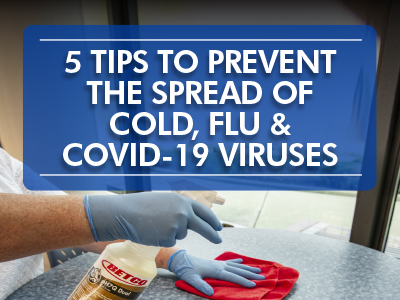Cleaning professionals play a crucial role in maintaining a clean and healthy environment. As cold and flu season approaches, extra action must be taken to keep facilities germ-free.
First, it's important to understand the difference between cleaners, sanitizers, and disinfectants.
- Cleaners are designed to remove soils, not kill germs.
- Sanitizers will reduce the number of germs present on surfaces, but not completely eradicate them.
- Disinfectants are the key to chemically killing up to 99.9999% of disease-spreading germs.
Read on to explore effective tips for creating a safer and healthier space.
1. Dwell on Time Well Spent
The U.S. Environmental Protection Agency (EPA) regulates sanitizers and disinfectants and requires that they list contact times on labels, detailing how long the product must sit on a surface before germs are killed. To maintain effectiveness, the surface must remain wet for the entire contact time, and if the product dries too quickly, it must be reapplied.
Each product’s label should be consulted prior to use to ensure proper contact time, which may range from a few seconds to several minutes, depending on the product or pathogen. Time overall is a challenge in the industry, but dwell time is not the place to cut corners. If there are substantial time pressures, opt for a product like Fight Bac™* that has a shorter contact time for cold, flu, and COVID-19 viruses — as long as it also fits your other needs.

2. Become a Pre-Clean Machine
While general cleaners will not kill germs, they should still be used in tandem with disinfectants and sanitizers, as soils on surfaces are known to limit the efficacy of disinfection. Did you know that the EPA tests disinfectants for a 5% soil load, which isn’t even visible to the human eye? That means that disinfectants may not perform as intended, even when you can’t see the soils. That’s why it's prudent to pre-clean surfaces that may not appear dirty, in addition to pre-cleaning visibly soiled surfaces.
Cleaners should be allowed to fully dry before application of disinfectants, and disinfectants should never be mixed with cleaners or other chemicals. This can cause toxic gases and can render ingredients useless.
3. Hit the Hotspots
No matter what the building’s purpose may be, each facility has critical touch points that receive maximum physical contact in high-traffic areas. Viruses can linger on these surfaces for hours to days, requiring consistent extra attention from cleaning professionals. Common touch points include doorknobs, handrails, tables in common areas, shared workplace equipment, water fountains, and more.
Implementing a more frequent cleaning and inspection schedule, especially during flu seasons or periods of increased illness, is highly recommended. To make disinfection of touch points more convenient, consider using an aerosol that dispenses a clinging foam (even when upside down), such as Cide-Bet II.

4. Rely on Hues for Better Hygiene
Color-coding cleaning equipment by cleaning task, surface, and/or area is an easy way for facilities to avoid cross-contamination. This includes rags, microfiber cloths, mop heads, mop buckets, and brushes. For example, red might be designated for high-risk or sanitary areas, green for general cleaning, blue for low-risk areas, and yellow for specialty cleaning tasks. This prevents unsanitary occurrences like a restroom rag from being used on a lunch table. As a bonus, color-coding provides a universal system that transcends language barriers.
Disposable wipes like GE Fight Bac™* Wipes can also minimize the risk of cross-contamination between different surfaces for cleaning staff and building occupants alike.
5. Close the Dispenser Loop!
Supporting proper hand hygiene prevents the rapid spread of viruses at a personal level. Ensuring that stations are functional and clean encourages handwashing. It's important to use closed-loop dispensing systems, as opposed to bulk dispensers, which can harbor bacteria when not properly maintained. The American Cleaning Institute recommends closed-loop systems such as Clario®* Manual and Touch-Free because they are factory-sealed, and therefore not susceptible to cross-contamination. Here are some top-selling Clario®* hand soap and sanitizer refills.
Hand sanitizing stations should also be strategically placed near locations, like entrances, exits, check-out counters, restrooms, cafeterias and break rooms, and any other high-traffic areas. To further reinforce the importance of proper hand hygiene, educational signage with CDC guidelines for handwashing can be placed around facilities, in restrooms, and near any other handwashing stations.
Cleaning professionals are the first line of defense against the spread of cold, flu, and COVID-19. By implementing the protocols and information above, cleaning teams can create a safe and hygienic environment within their respective facilities.
For more information, Betco®* offers free e-learning courses on topics that include Disinfection Basics, Restroom Sanitation, OSHA Hazard Communication Standard, and many more.

About Betco
Since 1950, Betco has been committed to helping our customers WIN in the commercial cleaning industry by providing more powerful, more reliable solutions. From cleaning chemistry to powered equipment, our lab-tested and field-proven products and programs will solve any facility challenge, including reducing cost, standardizing processes, increasing productivity, and enhancing cleanliness. Beyond our material offerings, our valued expertise and digital leadership inspire confidence and power growth. From the past and into the future, we continue to innovate, invest, and improve, all in service of our mission to deliver Professional Performance, Every Day.
*These are registered trademarks of Betco® Corporation. All rights reserved.















Comments